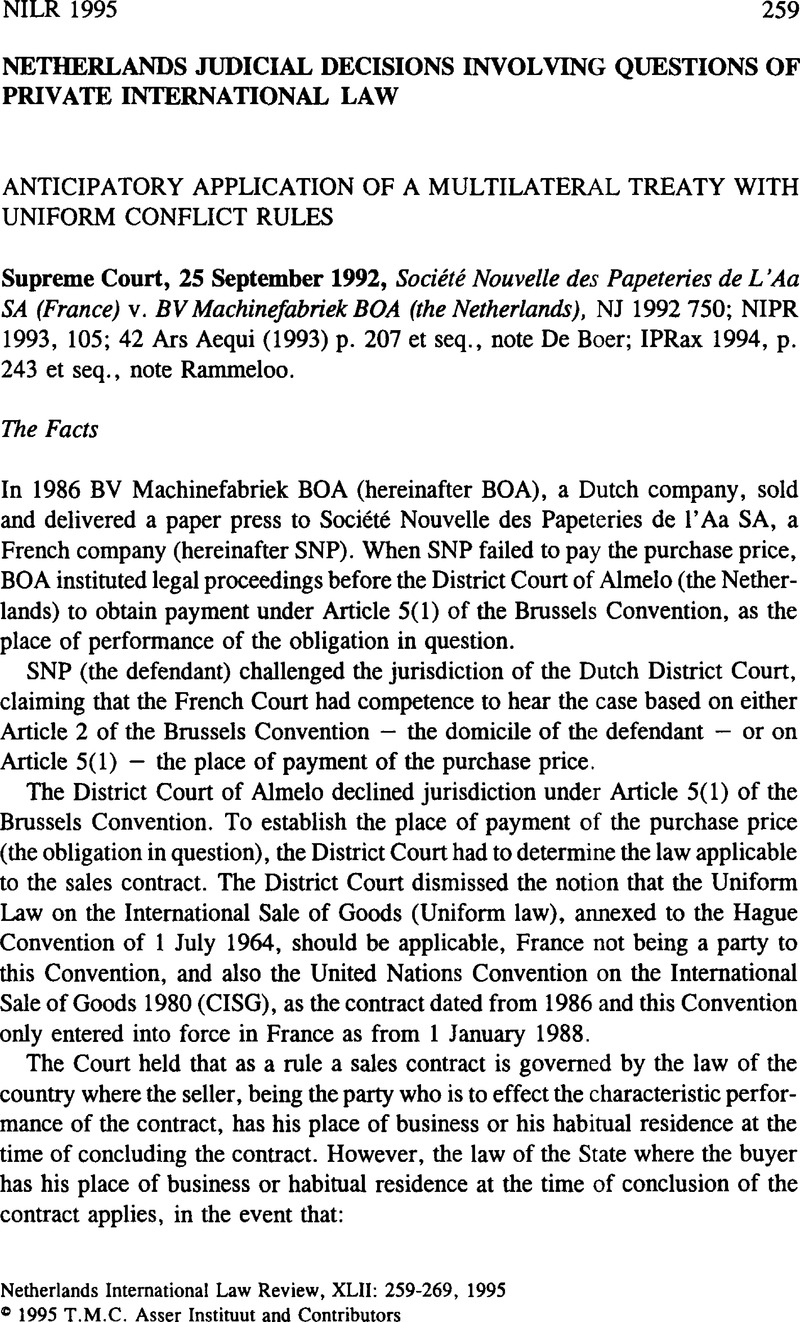No CrossRef data available.
Published online by Cambridge University Press: 21 May 2009

1. In the first instance BOA alleged that the choice of jurisdiction clause in the Smecoma Conditions (General Conditions applicable to the contract) conferred jurisdiction on the District Court under Article 17 of the Brussels Convention. The jurisdiction clause was held to be invalid by the District Court, the buyer had neither confirmed it in writing, nor was there a continuous business relationship between the parties. On appeal BOA no longer contended that the jurisdiction clause should apply.
2. Case 14/76,DeBloosv. Bouyer, [1976] ECR1497, NJ 1977 170 note Schultsz, NILR 1976 351 note Verheul, Rev. Crit. 1977 756 note Gothot and Holleaux. And Case 12/76, Tessili v. Dunlop, [1976] ECR 1473, NJ 1977 169, NILR 1976 349 note Verheul, Rev. Crit. 1977 752 note Gothot and Holleaux. See also EC Court of Justice, 29 June 1994, Case 288/92, Custom Made Commercial Ltd. v. Stawa Metallbau GmbH, ECR 1–2913, NILR 1994, 339 note Vlas.
3. The Court of Appeal ruled, however, that the Uniform Law was applicable, because Dutch conflict rules led to the applicability of Dutch law. See for the text of the Uniform Law: 834 UNTS (1972) p. 107 et seq.
4. Art. 17 reads as follows: ‘This Convention shall apply in a Contracting State to contracts made after the date on which this Convention has entered into force with respect to that State’.
5. The Netherlands signed the Hague Convention on the applicable law to the international sale of goods (12 December 1986), on 2 February 1990 (Trb. 1990 No. 41). The Dutch Government has decided that ratification shall not take place (TK 1991–1992, 22300 V, no. 77).
6. See de Boer, Th.M., ‘The EEC Contracts Convention and the Dutch Courts’, RabelsZ (1990) p. 51;Google ScholarRammeloo, S.F.G., Das neue EG-Vertragskollisionsrecht (1992)p. 20Google Scholar ets eq.; Boele-Woelki, K., ‘Exception Clauses in Private International Law’, in Exception Clauses in Conflicts of Laws and Conflicts of Jurisdiction — or the Principle of Proxomity (1994) pp. 235–271;Google Scholar Explanatory Memorandum to the Dutch Act of 31 January 1991 implementing the EC Contracts Convention, Stb. 1991 No. 53 TK 1988–1989 059 (R1356) no. 3, pp. 1–2.
7. See Vlas, P., ‘De eenmaking van verwijzingsregels: de Haagse Conferentie tussen idealisme en realisme, RM Themis 4/5 (1993) pp. 192–193.Google Scholar
8. See Court of Appeal of Leeuwarden, 4 April 1984, NJ 1984,745; District Court of Assen, 12 January 1988, NIPR 1988, 358; District Court of Almelo, 19 February 1986, a decision made known by Supreme Court, 14 June 1991, NJ 1992, 408; District Court of Haarlem, 1 May 1990, a decision made known by Supreme Court 10, January 1992, NJ 1992, 576; District Court of Arnhem, 27 June 1991, NIPR 1992, 99
9. See de Boer, Th.M., ‘Een Hollandse kijk op het EEG-Overeenkomstenverdrag: het Balenpers-arrest’, 42 Ars Aequi (1993) no. 3, p. 207 et seq.Google Scholar
10. An example of implicit anticipation can be found in Supreme Court, 10 December 1976, NJ 1977, 275 note Schultz, Chelouche v. Van Leer. The Supreme Court recognised the party autonomy of the future spouses in international matrimonial property law, which seemed to be inspired by the Hague Matrimonial Property Convention (1976).
11. Supreme Court, 8 June 1973, NJ 1973 400 (Mackay II).
12. OJ L48 of 20 February 1989. Report on the Protocols by Prof. Tizzano: OJ C 219 of 3 September 1990.
13. OJ C 282 of 31 October 1980.
14. See Bertrams, R.I.V.F. and Velden, F.J.A. van der, Overeenkomsten in het internationaal privaatrecht en het Weense Koopverdrag (1994) p. 32.Google Scholar
15. P. 21
16. See de Boer, loc. cit. n. 6, p. 50.
17. See also Boele-Woelki, loc. cit. n. 6, p. 258–262.
18. One example is found in Court of Appeal of 's-Hertogenbosch, 17 February 1993, NIPR 1993 273, where Art. 4(5) is applied by anticipation.
19. ‘Accidental’ place of business, see for other examples: Vischer, and Planter, Von, in lnternationales Privatrecht, 2 (1982) pp. 185–186,Google Scholar and Rammeloo, op. cit. n. 6, pp. 331–333.
20. See Supreme Court, 24 May 1991, NJ 1991 676 and Supreme Court, 1 November 1991, NJ 1992 422.
21. See North, P., ‘Is European Harmonisation of Private International Law a Myth or a Reality? A British Perspective’, Forty Years On: The Evolution of Postwar Private International Law in Europe (1990) p. 44.Google Scholar
22. See D. Kokkini-Iatridou, ‘Rapport gneral’, in Exception Clauses in Conflicts of Laws, op. cit. n. 6, p. 16 et seq.
23. Note Lagarde, P., Revue crit. dr. int. prive (1991) pp. 745–752.Google Scholar See on this decision also: Foyer, J. in J. du droit int. (1992) pp. 129–133;Google ScholarMondolini, J.D. in Rec. Dalloz Sirey (1992) Jur. pp. 174–176;Google ScholarGaudemet-Tallon, H. in Rev. trimestrielle du droit européen (1992) pp. 529–532;Google ScholarMestre, J. in Rev. trimestrielle de droit civil (1992) pp. 387–388;Google ScholarBandrac, M. in Rev. trimestrielle de droit civil (1992) pp. 604–605;Google ScholarOsman, F. in Les petites qffiches (1992) no. 88, pp. 14–18Google Scholaret La semainejuridique-édition générate (1992) II 21972. English text provided in European Current Law (1992) Part 6, No. 447 (excerpt).
24. Philip, A., ‘First Danish Decisions on the Rome Convention’, IPRax (1994) pp. 150–151.Google Scholar The Contracts Convention entered into force as national law in Denmark on July 1, 1984.
25. In Germany the Contracts Convention forms part of the national law. Art. 4(5) is reproduced in Art. 28(5) EGBGB.
26. Kokkini-Iatridou, loc. cit. n. 22, p. 18.
27. Art. 4(3) reads as follows: ’With regard to immovable property, the contract is presumed to be most closely connected with the country where the property is situated’.
28. Justice de Paix de Barvaux, 24 December 1985, S.A. Assurances Utrecht , J. Annales de droit de Liège (1988) pp. 102–104 and on appeal Tribunal civil de Marche- en- Famenne, 26 February 1987 pp. 100–102, note Hugues Born.